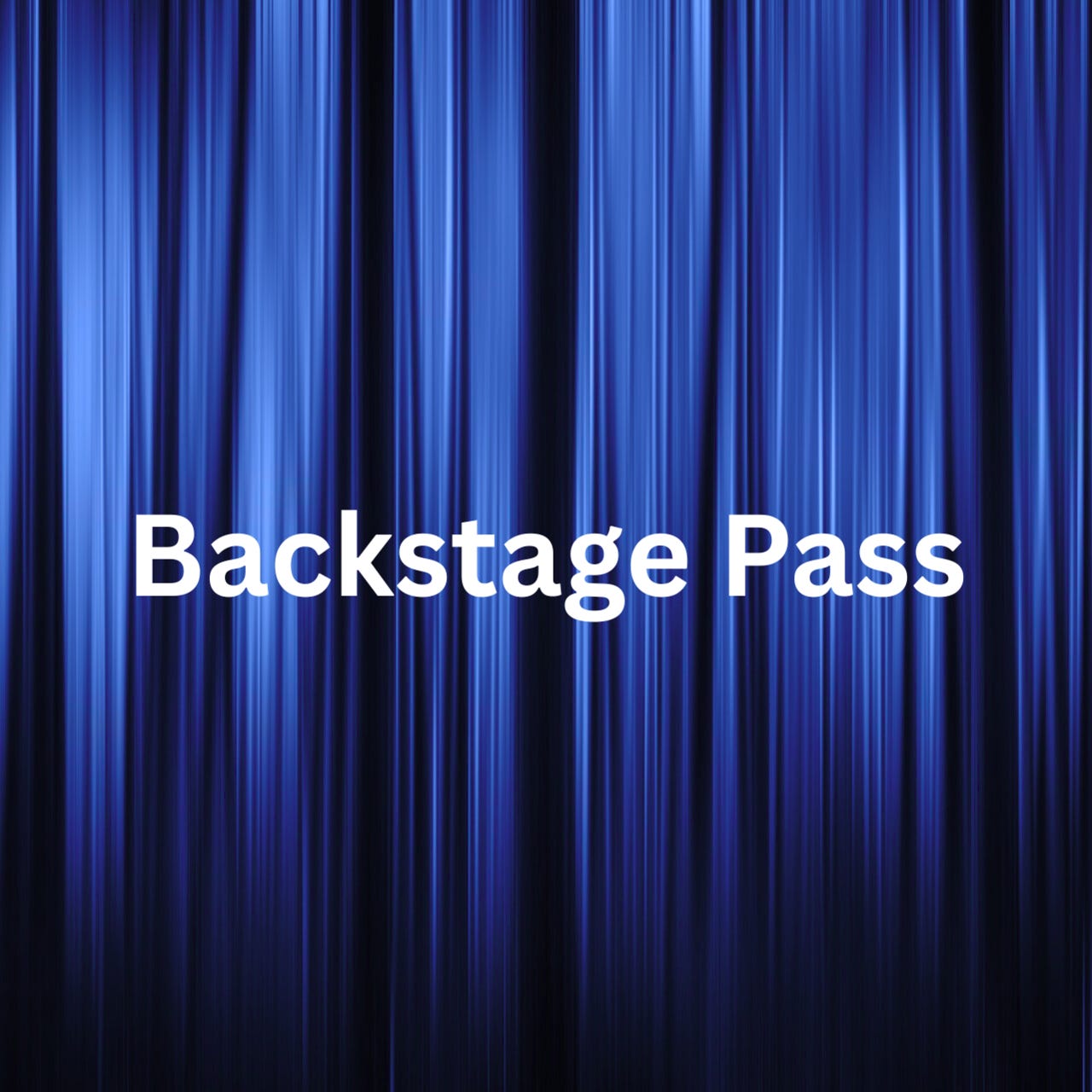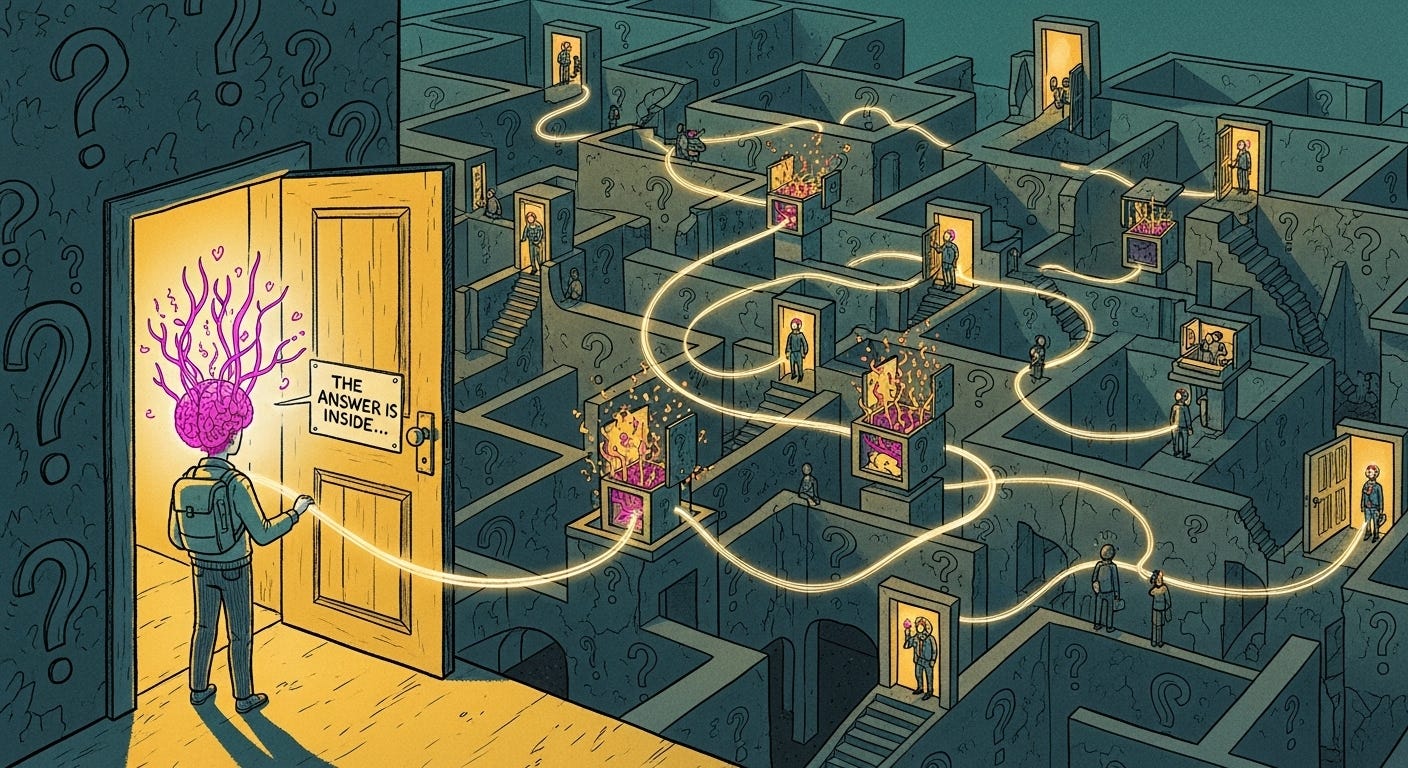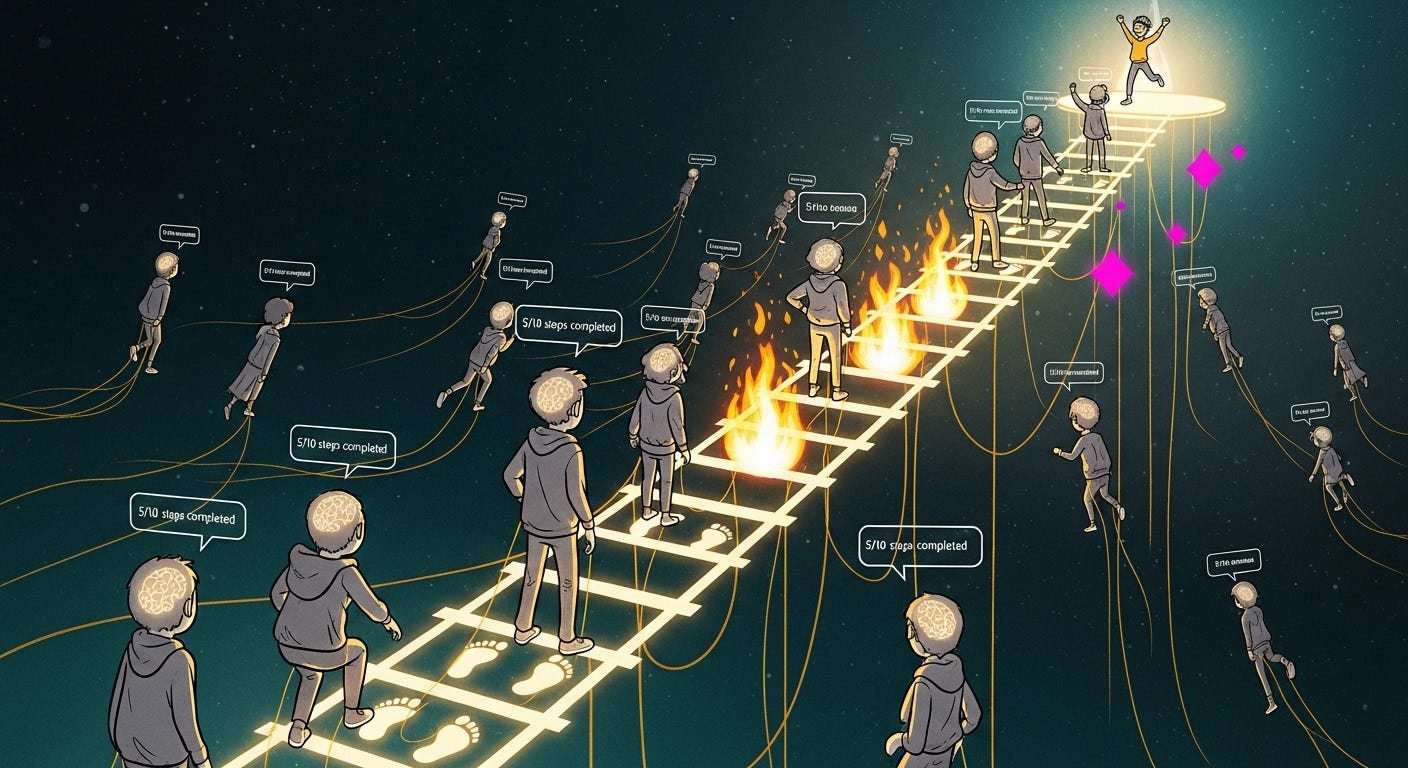Build your content like a movie trailer the brain can’t walk away from
How psychological triggers compound when you sequence them right, with AI workflows to build yours.
Welcome to today’s edition of ROBOTS ATE MY HOMEWORK. Today we’re exploring the dark arts of persuasion, the kind that makes your content impossible to ignore.
The greatest movie trailers you’ve ever seen don’t tell you the whole story. They show you just enough to create an itch you can’t scratch until you buy the ticket.
The best content works the same way. Movie trailers exploit a cognitive bias: your brain craves completion once a narrative begins. We make emotional decisions first, rationalize them later. Every psychological trigger in this guide taps into that reality.
Today I’m joined by
to take you through:The engagement triggers and conversion psychology that make readers stop scrolling and start participating
AI workflows to systematically build these triggers into your content at scale
Complete implementation systems so you can start using this immediately
👇 Check out Mack’s newsletter - a whopping 20 years of marketing psychology insights you won’t find anywhere else!
How psychological triggers work
Tapping into the psychology of our decision-making means tuning into how our brains truly make decisions.
We are not rational creatures, as much as we want to tell ourselves otherwise. We typically make emotional decisions, then justify them as being rational ones.
Using psychological triggers helps you tap into how our brain naturally makes decisions. It’s why they are so powerful, and the smartest creators use them to get better results for their content.
1. The Controversy/Contrarian Trigger
── .✦ The why…
A lot of the opinions we see online tend to run together. We all tend to repeat each other.
So when used correctly, employing a contrarian or controversy trigger can make your content pop. Here’s some examples:
Getting Eight Hours Sleep Every Night Could Be Making You Sick
Money CAN Buy You Happiness, But Only If You Spend It On This…
Fck It! New Research Shows Cursing Is Actually a Sign of Intelligence
The idea here is to challenge conventional wisdom or approaches and to give your readers a take on the topic that they hadn’t considered.
You know from your own experiences, but when someone makes a strong statement on a topic that you disagree with, you immediately want to say something. That means you’ve been triggered.
── .✦ The how…
Here’s how to systematically build controversy triggers using AI:
Step 1: Extract your industry’s “sacred cows”
Prompt:
You are a contrarian content strategist with 15 years of pattern recognition across [YOUR INDUSTRY]. You’ve analyzed thousands of pieces of conventional wisdom and identified which beliefs persist despite evidence to the contrary.
CONTEXT
Industry: [YOUR INDUSTRY]
Target audience: [SPECIFIC SEGMENT]
Current market maturity: [EMERGING / ESTABLISHED / SATURATED]
TASK
Generate 15 sacred cows—beliefs that nearly everyone in this industry accepts without question. For each:
1. State the belief in the exact language people use
2. Rate how widely accepted it is (1-10)
3. Identify the kernel of truth that made it believable
4. Note what’s changed that makes it outdated or incomplete
OUTPUT FORMAT
[BELIEF] | Acceptance: [SCORE] | Origin: [WHY IT SPREAD] | Gap: [WHAT’S WRONG NOW]
QUALITY FILTER
Each belief should make readers think “wait, I DO believe that” not “nobody thinks that.”
Prioritize beliefs that have business impact, not just tactical preferences.
EXAMPLE
“You should post daily on LinkedIn” | 9/10 | Origin: Algorithm favored frequency in X year | Gap: Current algorithm prioritizes dwell time over frequency; 3 deep posts beat 7 shallow onesStep 2: Generate your counter-narrative
Prompt:
Take this commonly accepted belief: “[BELIEF FROM STEP 1]”
Create a compelling contrarian angle by:
1. Identifying what’s wrong or incomplete about this belief
2. Providing a more nuanced or opposite perspective
3. Supporting it with logic, data, or examples
4. Making it specific to [YOUR AUDIENCE]
Format as a provocative headline and 3-sentence argument.Step 3: Add evidence and credibility
Prompt:
I want to argue that “[YOUR CONTRARIAN POSITION]”. Help me find:
1. 3 studies, experts, or data points that support this position
2. 2 examples of successful people/companies who did the opposite of conventional wisdom
3. 1 specific reason why conventional wisdom fails for [YOUR SPECIFIC AUDIENCE]
Support with evidence: studies, data, expert citations.2. The Identity Mirror
── .✦ The why…
I love this one. When you use The Identity Mirror, you are helping the reader to see themselves in your writing.
This is a wonderful psychological trigger to use because it forces you to be empathetic toward your audience. It forces you to consider the POV of your reader, and how to better appeal to their wants and needs.
One of the questions I always ask as I am writing is “Am I considering the POV of my reader?” I want to constantly be in touch with the pain points that my reader is facing, the things they want, the fears they are trying to overcome.
Here’s the pattern:
Generic = forgettable
Vague numbers or no numbers
“Many people” or “creators”
Abstract problems
Identity Mirror = “That’s literally me”
Specific numbers (32 posts, 8 comments, zero conversions)
“You’ve” statements (puts reader IN the scenario)
Concrete, visceral details (the confusion, the hope, the disappointment)
When people see themselves specifically reflected, their brain’s default mode network activates. They literally CAN’T help but engage because you’re describing their lived experience.
── .✦ The how…
Here’s how to “extract” your experience systematically and transform it into mirror language.
Step 1: Map your audience’s internal monologue
Prompt:
I’m writing for [YOUR SPECIFIC AUDIENCE]. Create their internal monologue when they face [SPECIFIC PROBLEM/SITUATION].
Include:
- Their exact thoughts and self-talk
- Specific numbers/metrics they worry about
- The emotions they experience
- What they’ve already tried
- Their secret fears and hopes
Write this as a 150-word internal dialogue using “I” statements.Step 2: Transform generic into mirror language
Prompt:
Transform this generic statement into “Identity Mirror” language:
“[YOUR GENERIC STATEMENT]”
Rewrite using:
- “You’ve” statements that put the reader in the scenario
- Specific numbers and metrics
- Concrete, visceral details about their experience
- Their actual thoughts and feelings
- What they’ve already tried and how it failed
Make them think “That’s literally me.”Step 3: Create the pattern recognition
Prompt:
I want to help [AUDIENCE] recognize a pattern in their behavior around [TOPIC]. Create 5 “Identity Mirror” statements that follow this format:
“You know that moment when you [SPECIFIC BEHAVIOR] and then [SPECIFIC CONSEQUENCE], and you think [SPECIFIC THOUGHT]? That’s because [INSIGHT].”
Make each one feel like I’m reading their mind.3. The Completion Compulsion
── .✦ The why…
We all want to finish a thought or idea if it’s left with a loose end. Or we want to continue reading to see what the payoff is.
Here’s an example: “Here’s the five surefire ways I have found to get more comments on my posts. What would you add to this list?” This encourages the reader to add their own take in a lightweight way that gives them an incentive to complete the list with ‘missing’ information.
There’s an important caveat to using The Completion Compulsion. It works best when you are discussing a topic that your readers are well-versed in.
In other words, you want to discuss a more 101-level topic, such as “How do we get more engagement on Substack” versus a more technical topic like “If silver hits $75 an ounce, how could that impact financial markets in London?”
Most of us have some general ideas on how to increase engagement, few of us have the slightest idea of how to analyze the current silver market. The point is, pick a more accessible topic and using The Completion Compulsion trigger will work well for you.
── .✦ The how…
So, how do you implement this in your actual content? It’s a simple matter of finding knowledge gaps → building curiosity loops → creating interactive completions.
Step 1: Identify your audience’s knowledge gaps
Prompt:
For [YOUR AUDIENCE], list 10 topics they think they understand but probably have incomplete knowledge about. These should be 101-level concepts in [YOUR INDUSTRY] where there are common misconceptions or missing pieces.
Format as: “Most people think they know [X], but they’re missing [SPECIFIC ELEMENT]”Step 2: Build curiosity loops
Prompt:
Create 5 different “completion compulsion” hooks for this topic: [YOUR TOPIC]
Use these formats:
1. “Everyone says [COMMON ADVICE], but I did [OPPOSITE] and here’s what happened...”
2. “Here are the [NUMBER] ways to [DESIRED OUTCOME]. Which one would you add?”
3. “I discovered [SURPRISING INSIGHT] after [SPECIFIC EXPERIENCE], and it changes everything about [TOPIC]...”
4. “Most people [COMMON BEHAVIOR], but here’s the one thing they’re all missing...”
5. “The biggest lie about [TOPIC] is [COMMON BELIEF]. The truth is [TEASER]...”
Make each one impossible to scroll past.Step 3: Create interactive completions
Prompt:
Take this topic: [YOUR TOPIC]. Create 3 different ways to invite readers to “complete” the content:
1. A list they can add to
2. A question that makes them evaluate their own situation
3. A challenge that requires them to take action
Each should feel low-effort but high-engagement. 4. Curiosity and Closed Loops
── .✦ The why…
We humans are wired to seek closure. Psychologists call it the “Zeigarnik effect”: we remember and focus on unfinished tasks more than completed ones. Applied to content, this means that if you open a loop, your readers have to close it.
You see this in content constantly online. Think of those videos you see on social media sites where a kid is at a zoo and a tiger is stalking up to the child behind the glass. You have to click the video to see what happens!
The same thing can be used with your content. Here’s an example:
You offer products or services to a particular industry (e.g. consulting for tourism). You could create an overview post about how AI can integrate with that industry. You start with a general overview, then offer a more in-depth white paper that’s specific to the tourism industry, with concepts and examples that also tie into the training workshop you are rolling out.
This works on multiple levels: First, it taps into the curiosity loop as a tourism pro will read the post, then wonder what’s in the white paper. They will sign up and get it, and in doing so they become a lead that you can connect with and discuss your training workshop with.
The idea with each form of content is you introduce the visitor to the concept or idea, and encourage them to get a more in-depth form of content by converting and taking a certain action. They get more valuable content, and in the process they signal intent to buy to you.
── .✦ The how…
Here’s how to systematically create curiosity loops that your audience can’t resist closing.
Step 1: Map your content journey with strategic gaps
Use this prompt:
I’m creating a content sequence for [YOUR AUDIENCE] about [YOUR TOPIC]. Help me design a multi-piece content journey that uses open loops.
For each piece, identify:
1. What information to reveal (the “hook”)
2. What information to withhold (the “gap”)
3. What the next piece promises to reveal
4. The specific call-to-action that bridges the gap
Create a 3-piece sequence: Social post → Lead magnet → Core offer
Make sure each gap is meaningful enough to drive action but not so vague that it feels like clickbait.Then, craft your opening hooks for the first piece:
I’m writing about [YOUR TOPIC] for [YOUR AUDIENCE]. Create 5 different opening hooks that use the curiosity gap technique.
Each hook should:
- Present a surprising fact or question
- Create cognitive tension (the gap between knowing and wanting to know)
- Hint at valuable information without revealing it
- Make it impossible NOT to keep reading
Format: One compelling sentence followed by “Here’s what I discovered...”
Avoid clickbait - make the curiosity authentic and valuable.Why both? The first prompt maps your macro-strategy (the full sequence). The second creates your micro-tactic (how you actually open the first piece). You need both to execute.
Step 2: Design your loop-closing mechanisms
As Mack said, when you open a curiosity loop, you create a psychological tension in your readers’ mind, and they want that closure. Now, how you close the loop determines whether they trust you enough to follow the next one.
Use this prompt:
I’ve opened a curiosity loop about [SPECIFIC TOPIC/PROMISE]. Now help me close it in a way that:
1. Delivers on the promise (no bait-and-switch)
2. Provides genuine value
3. Opens a NEW, deeper loop that leads to [NEXT CONTENT PIECE/OFFER]
Structure this as:
- The reveal (close the first loop)
- The deeper insight (add unexpected value)
- The new question (open the next loop)
- The bridge (how to get the answer)
Make the transition feel natural and helpful.Then, make sure you also create some pattern interrupt teasers that remove the “scrolling habit”. Make sure you’re not picking clickbait tactics… Use them as strategic ways to present familiar topics in unfamiliar ways.
Use this prompt:
I want to use the Zeigarnik Effect in my [CONTENT TYPE: email subject line/social post/video intro].
Topic: [YOUR TOPIC]
Audience: [YOUR AUDIENCE]
Create 7 different teasers using these formats:
1. The unfinished story: Start a narrative but stop at the critical moment
2. The shocking stat: Present data that contradicts expectations
3. The unanswered question: Pose a question they NEED to know
4. The partial list: “3 ways to [OUTCOME]... but the 3rd one is counterintuitive”
5. The mystery method: “I discovered [OUTCOME] using a technique nobody talks about...”
6. The failed attempt: “I tried [COMMON APPROACH] and it backfired. Here’s what worked instead...”
7. The hidden cost: “Everyone does [COMMON THING], but here’s what they don’t tell you...”
Each should create genuine curiosity through authentic value, not information withholding.5. Commitment and Consistency
── .✦ The why…
This trigger is truly the unsung hero of conversion triggers.
The idea is two-fold.
First, you want to ‘train’ your reader to become comfortable engaging with your content. The idea here is that once you start engaging with content, in whatever form, that you will become more comfortable engaging, and will continue to do so.
There’s an important caveat to this approach: You need to create a conversion flow for your audience. For instance, if someone arrives on a particular page on your website, what action do you want them to take?
When someone arrives at your content, what behavior do you want to see from them?
Subscribe to your newsletter?
Sign up for a free product trial?
Purchase a product or service?
Leave feedback?
You need to determine what actions you want them to take, and how they can perform those actions. Then you can craft your engagement flow so that the visitor becomes comfortable engaging with your content, and your CTAs can strategically move them toward the end action you want them to take.
── .✦ The how…
Here’s how to engineer commitment ladders that turn casual readers into devoted advocates.
Step 1: Map your engagement ladder
Before you can guide someone up a commitment ladder, you need to know what that ladder looks like.
This prompt helps you identify every possible micro-commitment in your content ecosystem.
Most creators only think about the top and bottom rungs. This exercise reveals the missing middle steps that make the climb feel natural rather than daunting.
I need to build a commitment ladder for [YOUR AUDIENCE] that leads to [ULTIMATE CONVERSION GOAL].
Map out 10-12 progressive actions from smallest to largest commitment, including:
- Passive actions (reading, viewing, scrolling)
- Low-friction engagement (likes, saves, follows)
- Active participation (comments, replies, shares)
- Personal investment (profile completion, preferences)
- Micro-conversions (downloads, sign-ups, free trials)
- Monetary commitments (purchases, subscriptions)
For each action, note:
- Effort level (1-10)
- Psychological barrier to overcome
- What makes someone ready for the next step
Identify where the biggest gaps exist between steps.— THINKING EXERCISE: The consistency audit —
Before creating new commitment mechanisms, audit your existing content for consistency friction. Ask yourself:
Where do readers engage with my content but have nowhere to go next? (Dead-end content kills momentum)
What’s the gap between my most common engagement and my desired conversion? (If people comment but you want email subscribers, what bridges that gap?)
Am I asking for too much too soon? (This is the #1 killer of conversion flows)
Which micro-commitments am I completely missing? (The more rungs on your ladder, the easier the climb)
Document these friction points. Your AI workflows should specifically address these gaps.
Step 2: Design micro-commitment content
This creates the actual content pieces that trigger small “yes” moments. Each piece is engineered to require minimal effort but create maximum psychological investment.
Use this prompt:
Create 5 micro-commitment opportunities for [YOUR CONTENT TYPE] that lead toward [GOAL].
For each, design:
1. The ask (what they do)
2. The immediate reward (what they get)
3. The identity shift (how they see themselves after)
4. The natural next step (where this leads)
Examples of micro-commitments:
- “Click to see the full strategy” (reveals content)
- “Save this for later” (bookmarking)
- “Pick your biggest challenge” (quiz/poll)
- “Drop a 🔥 if this resonates” (minimal engagement)
- “Take this 30-second assessment” (interaction)
Each should take less than 15 seconds but create investment.
Make the progression feel natural, not forced.Real-world example (newsletter commitment ladder):
Reader opens email (passive)
Clicks “read online” link (low friction - 5 seconds)
Saves article for later (slightly more commitment - curation decision)
Replies to an inline question (active participation - 30 seconds)
Downloads a template mentioned in article (micro-conversion - email confirmed)
Shares article with colleague (public commitment + identity signal)
Subscribes to paid tier (monetary commitment)
Notice: Each step requires only slightly more effort than the previous. The gap between “reply to question” and “download template” is tiny, they’ve already engaged, the download feels like a natural next step.
— FINAL MOVE: The Public Commitment Multiplier —
Public commitments are way more powerful than private ones.
Here’s how to leverage this without being pushy:
Social proof requests: “Share your goal in the comments - we’ll cheer you on”
Progress sharing: “Post your result and tag us”
Community challenges: “Join 500+ people doing [ACTION] this week”
Accountability partners: “Forward this to someone who needs to hear it”
6. Social proof
── .✦ The why…
This trigger can make a massive impact on your conversions IF you are willing to use it correctly.
Many of you hate promoting yourself. I get it, I really do.
There’s a better way: Let the numbers tell the story for you.
Talk about how you have used your own product or service to achieve desirable results. I’ve been creating content online for 20 years (Mack), and sharing my own results and those of my clients has been the most consistent driver of attention from my audience. Nothing packs a punch like adding actual numbers to a claim.
Which testimonial would be more relevant to you?
“I love this diet! It was easy to manage, I felt better and had more energy after just a few days!”
“I was on this diet for 12 weeks and lost 12 pounds. Did exactly what it claims to.”
The latter gives you real-world results, so most people would be more interested in it.
Put results in the spotlight. Your own numbers. Client transformations. Specific outcomes. Let the evidence sell. Either your own results, or those of your clients/customers. Remember, most customers/users don’t want to simply be told to buy something, they want to be shown results.
Give them a clear example of how your product or service will impact their life or business with real-world numbers, and it will get their attention.
Your social proof is your best promotion IF you are willing to lean into it.
── .✦ The how…
Here’s how to systematically extract, amplify, and deploy social proof that converts without feeling salesy.
Step 1: Mine your proof inventory
Most creators sit on a goldmine of social proof but can’t see it because they’re too close. This prompt helps you systematically extract every piece of evidence that demonstrates your value.
The key is getting specific: vague praise doesn’t convert, but “increased revenue by $47K in 8 weeks” absolutely does.
Help me create a comprehensive social proof inventory for [YOUR BUSINESS/CONTENT].
Extract and categorize proof across these dimensions:
1. QUANTITATIVE RESULTS:
- Your own metrics (revenue, audience growth, time saved, etc.)
- Client/customer results with specific numbers
- Before/after comparisons
- Time-to-result data
2. QUALITATIVE WINS:
- Testimonials with concrete outcomes (not just “it’s great!”)
- Specific problem → solution stories
- Unexpected benefits or transformations
- Emotional shifts (”went from overwhelmed to confident”)
3. AUTHORITY INDICATORS:
- Years of experience
- Number of clients/customers served
- Notable brands/people you’ve worked with
- Industry recognition or credentials
4. SOCIAL VALIDATION:
- Follower/subscriber counts
- Engagement metrics
- Community size
- Media mentions or features
For each category, identify the 3-5 most compelling pieces of proof.
Format as: [SPECIFIC METRIC/RESULT] + [TIMEFRAME] + [CONTEXT]
Example: “Helped 47 B2B SaaS companies increase demo bookings by an average of 340% within 90 days”Before deploying any social proof, run it through the skeptic’s filter:
The “So What?” test: Does this number actually matter to my audience? (10,000 followers means nothing if they’re in a niche where 500 engaged followers is more valuable)
The “Says Who?” test: Is this verifiable or does it sound like I made it up? (Add attribution, screenshots, or specific details that make it real)
The “Like Me?” test: Can my audience see themselves in this proof? (A Fortune 500 case study won’t resonate with solopreneurs - segment your proof)
The “Not Cherry-Picked?” test: Is this a typical result or an outlier? (If you show only your best result, you lose trust. Show ranges: “Most clients see 2-3x growth, with top performers hitting 5x”)
If your proof fails any of these tests, it weakens rather than strengthens your case. Fix it before using it.
Step 2: Transform proof into story-driven content
This prompt helps you take your proof inventory and transform it into narrative-driven content that readers can see themselves in.
Take this piece of social proof: [YOUR SPECIFIC RESULT/TESTIMONIAL]
Transform it into 3 different story-driven content pieces:
1. THE TRANSFORMATION ARC (300 words):
- Where they started (the pain, specific struggles)
- What changed (the turning point, what they implemented)
- Where they are now (specific results with numbers)
- What they say about the experience (direct quote)
Make me feel the before/after, not just see it.
2. THE NUMBERS BREAKDOWN (list format):
- The challenge: [specific problem]
- The timeframe: [how long it took]
- The approach: [what was different about the solution]
- The results: [3-5 specific metrics]
- The unexpected win: [bonus outcome they didn’t anticipate]
Make every number tell part of the story.
3. THE PATTERN REVEAL (insight format):
“After working with [X number] of [audience type], I’ve noticed something interesting: [pattern]. Those who [specific behavior] consistently see [specific result]. Here’s what that looks like...”
Turn individual proof into universal insight.
Each format should feel helpful and educational, not promotional.Don’t use the same testimonial or metric forever - it goes stale. Create a rotation system:
Fresh proof: Results from the last 30-60 days (shows current relevance)
Evergreen proof: Your strongest numbers that establish authority
Segment-specific proof: Rotated based on who’s reading (industry, experience level, goal)
Community proof: Real-time social validation (recent comments, shares, engagement)
Use AI to track which proof points drive the most engagement, then optimize your rotation. Keep your proof library living and breathing.
You just built your trigger stack
Most people apply triggers in isolation. Each trigger lives in its own silo.
Going through the process above, you’ve built yourself a trigger stack, a deliberate combo that multiplies effectiveness:
The Trust Stack:
Identity Mirror (you see yourself)
Social Proof (others like you succeeded)
Commitment ask (low-friction first step)
The Momentum Stack:
Curiosity Loop (open question)
Completion Compulsion (incomplete information)
Commitment Ladder (small yes → bigger yes)
The Conversion Stack:
Controversy (pattern interrupt)
Identity Mirror (make it personal)
Social Proof (validate decision)
Closed Loop (deliver payoff + new question)
You’re now equipped to remove friction systematically.
What I’d love for you to do this week: pick ONE trigger from this newsletter and apply the AI workflow to a piece of content you’re working on right now. Reply and tell me which trigger you chose and what happened.
And if this collab between psychology (
’s expertise) and AI systems (my obsession) clicked for you, let us know, we might do this again 💫To designing for brains that actually exist,
Chief 🤖 at ROBOTS ATE MY HOMEWORK
🔎 Your brain just decided to keep going (see, triggers work). Here’s more on building systems that perform:
















Love this, Mia and Mack! Definitely saving it, can’t wait to test it on my next posts.
I’m curious: Did you use these prompts while writing this one? Or have you done a full piece using the complete set? :)
Absolutely brilliant. Thank you!